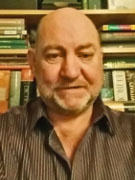Teaching
My teaching
I am currently responsible for teaching;
Thermodynamics (SPA5219), a second year module covering thermodynamics.
Electromagnetic Waves and Optics (SPA5222), a second year module covering physical and geometric optics.
Research
Research Interests:
My research interests
1. Single Walled Carbon Nanotubes. The induced polarisability of single walled carbon nanotubes, SWCNTs, has provided a powerful tool for their study. While there is no permanent dipole moment the induced dipole can be substantial at even moderate fields allowing the manipulation of the SWCNTs under the action of various forces. This leads to several related but seperate studies;
(i) Dielectrophoresis.The differential polarisability of different species of SWCNT, specifically metallic and semiconducting, make the dielectrophoretic force an interesting candidate for use in the separation of SWCNTs. In a non-uniform electric field the induced dipole experiences a dielectrophoretic translational force and the motion of nanotubes under the action of such forces is the subject of study. Of particular interest is the relationship between Brownian and viscous forces and their action on nanoscale objects compared with the more familiar mesoscale objects described by classical hydrodynamics
(ii) The Kerr Effect. In a uniform electric field, SWCNTs in suspension will experience a rotational torque and can be made to rotate in viscous media. The consequent alignment renders a previously isotropic suspension anisotropic and thus birefringent (refractive index depending on polarisation state of light). The study of rotational dynamics of nanoscale objects becomes possible by imposing transient electric fields.
(iii) Induced Dichroism. Similarly, in a uniform field the isotropic sample will become increasingly dichroic (absorption depending on polarisation state of light) as alignment proceeds. Dynamic studies are undertaken of induced linear dichroism in order to more closely relate the dynamics of nanoscale objects to their well studied mesoscale counterparts.
(iv) Rheology of SWCNT suspensions. The application of a controllable torque and the measurement of the dynamic response of SWCNTs allows study of the efffect of the SWCNTs on the viscosity of their local environment and how the nanotube concentration affects this.
(v) Other CNTs; All of the previously referred to techniques are applicable to Double Walled Nanotubes, DWNTs, and Multi-Walled Nanotubes, MWNTs and these too are under study.
2. Charge carrier transport on Polydiacetylene Single Crystals.
Electron (hole) transport on the backbone of conjugated polymers might be considered to be similar to that in silicon as both are covalently bonded structures. The conjugated polymer backbone is one dimensional in contrast to the three dimensional silicon lattice and this difference in dimensionality will make a difference to transport properties. Certain conjugated polymers of the polydiacetylene group may be grown first as macroscopic monomer single crystals and these may be subsequently polymerised to give macroscopic polymer single crystals. Such highly perfect single crystal polymers offer a unique opportunity to study the transport of free carriers on a conjugated one dimensional backbone.
Such studies have revealed, through transient photoconductivity techniques, a unique behaviour that comes about as a result of their one dimensionality. The electrons (holes) in the conduction (valence) band in this one dimensional semiconductor, strongly couple with lattice distortions and travel with the distortion as solitons or solectrons, at around the velocity of sound independent of the applied electric field. Further, the dissipation of these solectrons by phonon scattering is extremely weak and the saturated velocity is reached at very low electric fields.
Transient photoconductivity studies.
The technique of photoconductivity including time resolved photoconductivity with temporal resolution covering times from 100 picoseconds to DC is used to study the effects of reduced dimensionality on charge transport. The high end of this temporal resolution is among the fastest achieved anywhere, worldwide. The Auston switch technique has been developed to this end with a novel application for samples suspended in solvents and contained in an integrated co-axial geometry cell based around the Auston technique.
The Solectron Field Effect Transistor, SFET.
Given the transport properties of polydiacetylenes described above, it is of interest to use the polydiacetylene chains as the channel between source and drain electrodes on a single crystal. The solectron will travel at the velocity of sound ( 2 km/s) even at very low source-drain voltages (electric field) and the creation of a field effect transistor, FET, by addition of a gate electrode above the channel and separated from it by a thin insulator layer will exhibit unusual current-voltage characteristics. Specifically the solectron FET, SFET, can be expected to operate at very low power compared with conventional devices. Because the single crystal character of the polydiacetylene does not allow doping it is necessary to introduce the carriers into the channel by using an injecting electrode for the source. A further potential problem is that the trapping of an electron within the channel at a defect will result in an impediment to introduction of further carriers due to Coulomb repulsion. Highly perfect crystals are therefore needed and it is possible to obtain crystals with an on chain defect separation of 500 microns. If the channel length is much shorter than this the problem should not arise.
3. Charge Transport; Other organic materials demonstrate the effects of reduced dimensionality on charge transport. This is a situation commonly encountered when the condensed matter is held together by a mixture of Van der Waals and covalent bonding and has consequences for the rate of trapping and bimolecular recombibnation which have been studied.
The charge transport in a range of organic materials has been studied and these include;
(i) Columnar, Discotic Liquid Crystals.
(ii) Carbon nanotubes.
(iii) Polydiacetylene conjugated polymers.
(iv) Langmuir Blodgett multilayers.
